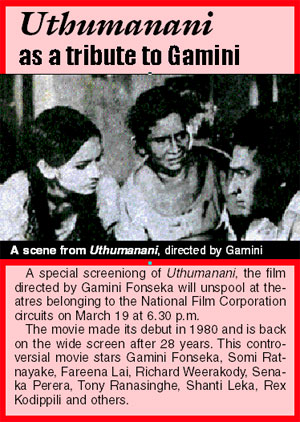|
Projector |
- Compiled by Ruwini JAYAWARDANA |
|

Gamini Fonseka, the Emperor of Sinhala cinema. |
Remembering Gamini
The 72nd birth anniversary of the film legend falls
on March 21:
Ruwini Jayawardana
The 72nd birth anniversary of the late veteran film actor, director
and lyricist, Gamini Fonseka, falls on Friday. He was the undisputed
hero of the wide screen during the golden era of Sinhala cinema and had
breathed life into many memorable roles.
Born Sembuge Gamini Shelton Fonseka in 1936 he schooled at S. Thomas’
College, Mount Lavinia. He made his entrance to cinema as a technical
assistant in Dr. Lester James Peries’ Rekhawa in 1955. It did not take
long for the spotlight to fall on this enthusiastic youth.
He faced the camera for the first time in David Lean’s Oscar winning
creation “The Bridge on the River Kwai” and then went on to act in S.K.
Oja’s Daiva Yogaya.
However it was his third film that carved his destiny. His portrayal
of the second lead in Dr. Lester James Peries’ Sandeshaya took him to
unimaginable heights.
 A star was born and with many offers flooding his path the legend
rolled on. He ruled the 1960s and 70s playing many lead roles in box
office hits and starred in the first Sinhala colour film Ranmuthuduwa.
Fonseka clinched the inaugural Sarasaviya Best actor award for his
performance as Jinadasa in Lester’s Gamperaliya and bagged several
awards for best actor and most popular actor. A star was born and with many offers flooding his path the legend
rolled on. He ruled the 1960s and 70s playing many lead roles in box
office hits and starred in the first Sinhala colour film Ranmuthuduwa.
Fonseka clinched the inaugural Sarasaviya Best actor award for his
performance as Jinadasa in Lester’s Gamperaliya and bagged several
awards for best actor and most popular actor.
His first film direction was Parasathumal in 1966 and then he
followed it up with creations like Sagarayak Mada, Uthumaneni, Sakwithi
Suwaya, Koti Waligaya and Mayurige Kathawa.
The award-winning star then turned to politics, contested for the
Matara electorate on the UNP ticket in 1989 and acquired around 19,618
preferential votes, the highest in the district.
He was appointed as deputy speaker and later in 1995 he became
Governor of the North Eastern province under the PA Government.
Fonseka had also contributed to stage plays like “Julius Caesar”, “My
Fair Lady”, Sudo Sudu and teledramas like D.B. Nihalsinghe’s Sudu Saha
Kalu. Gamini penned some popular lyrics like Ahimi Unath Numba Lande and
Bambarindu Bambarindu. His last film Anthima Reya was also his last
direction.
More than three years had passed since the demise of Gamini Fonseka
but his contributions are still fresh in the minds of moviegoers, making
him the true “Emperor of Sinhalese cinema” till date.
Aadara Meena debuts at Ritz
|

Keerthi, Saddatissa and Nilanthi
|
|

Nilanthi and Roshan. Pictures by Saman Sri Wedage
|
Aadara Meena, the film directed and scripted by Keerthi Bandara is
screening at Ritz cinema, Borella, and other theatres of the National
Film Corporation’s Ritma circuit.
The film portrays a tale stressing the importance of ethnic harmony
between Sinhala and Tamil parties in the island. These issues are
projected through a love story bridged between a Tamil lass (Meena) and
a Sinhala boy (Roshan).
Nilanthi Dias and Roshan Pilapitiya play the two lead roles. Shriyani
Amarasena, Cletus Mendis, Baptist Fernando, Douglas Ranasinghe, Geetha
Kanthi Jayakody, Keerthi Bandara, Nilanthi Heendeniya, Ananda
Weerasinghe, Sarath de Silva, K.D. Chandraratne, Kamalsiri Perera, Ruwan
Amarasekara, Kumudu Palitha Jayaweera, Madu Niroshani, Renuka Damayanthi,
Asha Udayangani, Hemaka Bandara, Suranga Nilushiya, Prasadi de Mel,
Sandya Subashini, Prasadi Apsara Jayani and others have also taken part.
|

Geetha Kanthi lights the oil lamp at the premier of Aadara Meena |
The cameraman is Yapa Bandara Kularatne while Tilakaratne Liyanage is
the assistant director.
Asela Indralal is the music director, Hemasiri Halpita, Malar Ranban
and Asela Indralal had penned the lyrics and Damitha Abeyratne and
Kalawathi had contributed in vocals. Sarath de Silva was the fight
director, Tharaka Adikari was the make up artist, Donald Mapalagama was
the art director, Sham Navas and Nilanthi Dias had been in charge of the
choreography.
Kamalasiri Perera had been in charge of the still photographs. Ranil
Hapuarachchi was the editor while Ruwan Amarasekara is the production
executive for Aadara Meena.
The movie is the maiden production of Saddatissa Kaldera. – RJ
La Ceremonie
A well-constructed French film:
K.S. SIVAKUMARAN
|

Isabelle
|
|

Sandrine |
|

Virginnie |
|

Jaqueline |
La Ceremonie (The Ceremony), a remarkable film ideally constructed in
terms of the grammar of cinema by a Frenchman, Claude Chabrol, some 14
years ago, typifying the trends of film making in that period, was one
of the films included in Bonjour Cinema 2008 held at the BMICH. I liked
the film because the director had presented the story in an intelligible
and entertaining way despite including serious statements.
The film appealed to me in several ways as it is intimated in a
structured manner unfolding its several layers. I shall briefly list
them for your enjoyment in a moment.
The film features some outstanding actors in the international
cinema: Isabelle Huppert, Sandrine Bonnaire, Jaqueline Bisset, Virginnie
Ledoyen and Jean- Pierre Cassel. In fact the film involves four women
each with a different personality.
One is an eccentric postal worker whose child had died due to an
accident and while another is a maid who had also lost her child due to
a fire. Both are middle-aged women from the proletariat. There are two
others: a model of yore and her stepdaughter, both belonging to the
bourgeoisie.
In one sense the film portrays the vendetta of the frustrated and
underprivileged women against the upper class family that takes life at
ease with its own private affairs and a mindset of dominance.
Most critics in the orient consider the story value, as the primary
requirement of a good film but in the west, the form and presentation in
cinematic language is essential too.
Giving the director the liberty to present his film in his own point
of view or perspective, we can also interpret the film as we read it,
but of course taking into consideration the period in which the film was
made.
The establishment shot and the immediate subsequent frame foretells
the inherent outcome of the story. The conversation between and among
the participants in this drama is both refined and colloquial. Silence
at some places in the film contributes to the accentuation movement of
the images in the film.
Apart from the visual images deliberately and functionally
constructed (since this is a column of short length I may not give
examples in detail and then explain), the strength of the film lies in
the characterisation of the protagonists and the antagonists.
The ironies and paradoxes that come over in the film within the
confines of space in it and the subtle message translated in implicit
transference make the viewer to think about the film even after its
natural end.
La Ceremonie begins ordinarily (for an uninitiated film buff) and
climaxes with unexpected divine justice as if to give a spiritual
interpretation of the whole design of the film’s structure.
The film is a conglomeration of many concepts such as sociological,
cultural, Marxian, hypocritical, satirical, realistic, spiritual,
feminist and the like.
In a full-fledged analytical criticism, I could justify perhaps, my
contention and understanding of this film giving examples of the
striking images in the film for the viewer’s understanding of good
cinema.
Readers of my two columns in this newspaper must have read my short
notes on another outstanding film included in the festival “4 Months, 3
Weeks, and 2 Days”.
Jean Philippe Tesse who writes for the French highbrow film journal
Cahiers du Cinema was very helpful to film personalities and us
journalists during the four days preceding Bonjour Cinema. Dr. Tissa
Abeysekera, Sanath Gunathilake and other notable cineastes were among
the participants at the workshop.
[email protected]
‘Robot’ back on track
The pooja of the mega movie ‘Robot’ bringing together Shankar and
Rajnikanth will be held around April 14 and the movie will go to the
floors by May.
Though the unexpected demise of writer Sujatha, who was working with
‘Robot’ team, had shocked the entire team, the film will soon be kick
started. Since Sujatha is one of the few Tamil writers, who are well
versed in scientific matters, it would be a challenging task for the
director to find a suitable person to write the dialogues for the
science fiction movie. It is expected that Rajini would finish his
portions in Kuselan before taking on ‘Robot’.
Cine Directory 2008
The 2008 version of annual Cine Directory presented by the National
Film Corporation is available at its premises. The directory provides
information required for any individuals or organisations involved in
the fields of film and media. |

